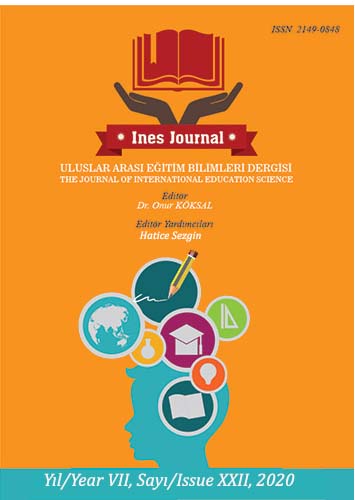Author :
Abstract
Bu çalışmada öğrencilerin kesirlerdeki şemalarının nasıl olduğunun belirlenmesi amaçlanmıştır. Çalışma, Türkiye’nin batısındaki devlet ortaokullarından birisinde öğrenim gören 12 tane 7. sınıf öğrencisi üzerinde uygulanmıştır. Çalışma durum çalışması niteliğinde olup, çalışma verileri birebir görüşmeler yoluyla toplanmış ve toplanan veriler betimsel analiz kullanılarak analiz edilmiştir. Çalışmada öğrencilere uzunluk, alan ve küme modelleri ile çeşitli kesirler verilmiş ve öğrencilerin bu kesirleri ifade ederken aynı anda parçalama, eş parçalama, basit parçalı birim kesir, çarpımsal bileşim zihinsel düzeneklerini nasıl kullandıkları ortaya çıkarılmıştır. Veriler analiz edildiğinde öğrencilerin en fazla küme modeline ilişkin sorularda zorlandıkları ve özellikle de çarpımsal bileşim zihinsel düzeneğine ilişkin zihinsel şemalarının problemli olduğu belirlenmiştir. Bulgular ışığında; yapılan öğretim uygulamalarında kesrin özellikle küme modeli gibi farklı modellerinden de yararlanılması, kural ezberletmek yerine kavramların anlamına ağırlık verilmesi tavsiye edilebilir.
Keywords
Abstract
In this study, it was aimed to determine how students' schemes were in fractions. The research was performed on 12 students studying in one of Turkey's western state secondary school 7th grade students. The study is a case study. The data were collected through one-on-one interviews and the collected data were analyzed using descriptive analysis. In the study, students were given various fractions with length, area, and cluster models, and it was revealed how students used mental mechanisms of shredding, peer breaking, simple fractional unit fractions, multiplicative composition at the same time. When the data were analyzed, it was determined that the students had difficulties in the questions related to the cluster model and especially the mental schemes related to the mental composition of the multiplicative composition were problematic. In the light of the findings;, it may be recommended to use different models of the fraction, especially the cluster model, and to focus on the meaning of concepts instead of memorizing rules in teaching practices.
Keywords
- Aksu, M. (1997). Student perfomıance in dealing with fractions. The Journal of Educational Research, 90 (6), 375-380.
- Altun, M. (2005). Matematik öğretimi. Bursa: Alfa Aktüel Yayın Dağıtım.
- Akbaba Dağ, S. (2014). Mikroöğretim ders imecesi modeli ile sınıf öğretmeni adaylarının kesir öğretim bilgilerinin geliştirilmesine yönelik bir uygulama. (Doktora Tezi)
- Alacaci, C. (2014). Öğrencilerin kesirler konusundaki kavram yanılgıları. E. Bingölbali ve M. F. Özmantar (Ed.), İlköğretimde karşılaşılan matematiksel zorluklar ve çözüm önerileri (s. 63-95). Ankara: Pegem Akademi Yayınları.
- Bingölbali, E., Arslan, S. ve Zembat, İ. Ö. (2016). Matematik Eğitiminde Teoriler. Ankara: Pegem Akademi.
- Çelebioğlu, B. (2014). Kesir kavramına ilişkin bilgi oluşturma sürecinin incelenmesi (Doktora Tezi)
- Çelik, B. (2015). Beşinci sınıf kesirler konusunun öğretim sürecinin matematiksel modeller açısından incelenmesi, (Yüksek Lisans Tezi)
- Eliustaoğlu E. (2016). Investıgatıon of fraction schemes and models as a means to understand how sixth grade students make sense of fractions. (Yüksek Lisans Tezi)
- Eroğlu D. Camci F. Tanişli D. (2019). Altıncı sınıf öğrencilerinin kesirler ve kesirlerdeki toplama- çıkarma konusundaki bilgilerinin yapılandırılmasına ilişkin tahmini öğrenme yol haritası. Pamukkale Üniversitesi Eğitim Fakültesi Dergisi (PAU Journal of Education) 45:116-143
- Ertuna L. (2013). İlköğretim 4-7. sınıf öğrencilerinin denk kesirlerin sembolik ve grafiksel temsillerini ilişkilendirme becerilerinin incelenmesi. (Yüksek Lisans Tezi)
- Haser Ç. ve Ubuz B. (2002). Kesirlerde Kavramsal ve İşlemsel Performans, Eğitim ve Bilim, 27 (126), 53-61.
- Haser Ç.ve Ubuz B. (2001). İlköğretim 5. sınıf Öğrencilerinin Kesirler Konusunda Kavramsal Anlama ve İşlem Yapma Performansı, IV. Fen Bilimleri Eğitimi Kongresi, s: 609-612, MEB Yay.,Ankara.
- Kara, F. (2017), Altıncı sınıf öğrencilerinin kesirlerde toplama ve çıkarma işlemlerinde farklı temsilleri kullanma becerilerinin incelenmesi. (Yüksek Lisans Tezi)
- Milli Eğitim Bakanlığı (2018). Matematik Dersi Öğretim Programı (İlkokul ve Ortaokul 1, 2, 3, 4, 5, 6, 7, ve 8. Sınıflar). http://mufredat.meb.gov.tr adresinden erişilmiştir.
- Öksüz (2018), 5. sınıf öğrencilerinin kesir kavramını oluşturma süreçlerinin apos teorik çerçevesinde incelenmesi. (Yüksek Lisans Tezi)
- Pesen C. (2007). Öğrencilerin Kesirlerle İlgili Kavram Yanılgıları. Eğitim ve Bilim 32(143).
- Siap, İ. ve Duru, A. (2004). Kesirlerde Geometriksel Modelleri Kullanabilme Becerisi. Kastamonu Egitim Dergisi, 12(1), 89-96
- Steffe, L. P., & Olive, J. (Eds.). (2010). Children’s fractional knowledge. New York, NY: Springer
- Temur, Ö. (2015) Dördüncü ve beşinci sınıf öğretmenlerinin kesir öğretimine ilişkin görüşleri: fenomenografik araştırma. Dumlupınar Üniversitesi Sosyal Bilimler Dergisi. (29)
- Van de Walle, J. A., Karp, K. S. & Bay-Williams, J. M. (2014). İlkokul ve ortaokul matematiği, gelişimsel yaklaşımla öğretim (S. Durmuş, Çev.). Ankara: Nobel EKLER
